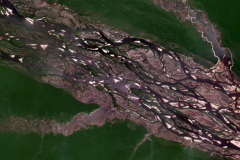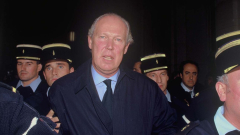- Brazil’s President Lula made important contributions to COP28 in demanding that the 1.5°C temperature increase limit be respected, in recognizing the risk of Amazon forest collapse, and in promising to end Brazil’s Amazon deforestation by 2030.
- Lula failed to explain how zero deforestation would be achieved, implicitly relying only on the Ministry of Environment’s command and control operations against illegal clearing. The causes of deforestation must be addressed, many of which are being strengthened by the rest of Lula’s presidential administration.
- These include legalization of illegal land claims in government land and highway projects such as BR-319 and associated side roads that would open vast areas of Amazon forest to the entry of deforesters. Brazil’s plans for opening new oil and gas extraction areas and expanding existing ones contradict the discourse on limiting temperature rise to 1.5°C.
- This post is a commentary. The views expressed are those of the author, not necessarily of Mongabay.
Positive changes
President Lula’s speeches at the Climate Conventions 28th Conference of the Parties (COP28) in Dubai contained positive signs for Amazonia and for mitigating climate change. Brazil had the good news to present that the country’s Amazon deforestation was “almost 50%” lower in the last 10 months than in the same months in the previous year, that is, during the disastrous Bolsonaro presidential administration. In both of his speeches at COP28, President Lula recognized the absolute necessity of keeping average global temperature within 1.5 °C of the pre-industrial average and that otherwise the Amazon forest is likely to collapse. This contrasts with Brazil’s diplomatic past, as in 2007 during Lula’s previous time in office when Brazilian diplomats tried unsuccessfully to delete mention of this risk from the summary of the fourth Intergovernmental Panel on Climate Change (IPCC) report. Ironically, just six days after this incident, Brazil’s then (and present) minister of the environment Marina Silva gave a speech in which she said exactly what Lula said about this risk 16 years later at COP28.

Climate denial flourished in Brazil during the 2011-2016 presidency of Lula’s protégée Dilma Rousseff. Prior to the 2015 Paris Agreement, Dilma personally repressed a government report predicting grave impacts of climate change in Brazil by 2040 and fired the report’s authors. She also appointed a virulent climate denier to be minister of science and technology. The peak of denialism was reached in the 2019-2022 presidency of Jair Bolsonaro, who promised to withdraw Brazil from the Paris Agreement, but was ultimately dissuaded due to the risk of boycotts of Brazil’s soy exports.
President Lula’s present positions are a welcome change from the past. However, his discourse at COP28 was marked by omissions and missed opportunities.
Zero deforestation
President Lula promised “zero deforestation” by 2030 without inserting the fatal qualifier “illegal” deforestation. After his election in 2022, Lula gave a speech at COP27 in Egypt, where promised to “spare no effort” to achieve zero deforestation by 2030, without including the qualifier “illegal,” but in the months since then his discourse has always referred only to eliminating “illegal deforestation.” This is very different, since illegal deforestation can also be achieved simply by legalizing the deforestation that is taking place, and key parts of Lula’s agenda would do just that.
In recent years, about half of the deforestation in Brazilian Amazonia has taken place in “undesignated public lands,” that is by either small squatters or large landgrabbers in government land that has not been assigned to a specific use, such as a protected area. Lula has repeatedly promised land “regularization,” a euphemism for legalization of these illegal land claims, and he announced that he plans to create a “shelf” for distribution of the undesignated public lands. Doing so not only legalizes the past deforestation in the new properties, it also allows the new landowners to obtain licenses for legal deforestation in the future. The argument that legalization slows deforestation is false: illegal landholdings legalized in a similar program during Lula’s previous presidential administrations increased their deforestation compared to similar illegal landholdings that were not legalized. “Regularization” of land claims is an important part of Lula’s domestic agenda, and it will continue to drive deforestation as long as this practice continues.

While promising zero deforestation is a great advance, the most important question is how this will be achieved. There appears to be no departure from the pattern of simply handing the problem of deforestation over to the Ministry of Environment to control, while the rest of government proceeds with measures that increase deforestation and emissions. The Ministry of Environment’s role in inspecting and fining those who deforest illegally has a real effect, as shown by the recent deforestation decline, and this command-and-control is essential in order to prevent a generalized presumption of impunity. However, this is not enough to halt all deforestation, and this will be even more evident as more deforestation fronts are opened by planned developments.
Lula’s minister of transport wants to rebuild Highway BR-319, and even wants to use money from the Amazon Fund to cover costs of mitigating what would be a small fraction of the road’s enormous environmental impacts. BR-319 would connect the notorious “arc of deforestation” in southern Amazonia to the relatively undisturbed area of Manaus in central Amazonia, and migration of deforestation would spread to all areas already connected to Manaus by road, including Roraima, and to the vast Trans-Purus forest area in the western part of the state of Amazonas that would be opened by planned side roads such as AM-366. BR-319 was built in 1973-1974, abandoned in 1988 and is now seasonally passable through a “maintenance” program begun in 2015.

BR-319 and associated side roads would open to deforestation roughly half of what remains of Brazil’s Amazon forest, including the largest areas of the undesignated public lands that are most attractive to landgrabbers, organized landless farmers, loggers and other actors. The area to be opened is essential to maintaining Amazon forest’s the water cycling function that provides water vapor that is transported via the winds known as “flying rivers” which is essential to maintain the water supply for the city of São Paulo and contains huge stocks of carbon that, if released, would push global climate past a catastrophic tipping point.
It can be taken as a positive sign that neither of Lula’s two addresses at COP-28 mentioned planting trees or forest restoration in Brazil’s plans for mitigating climate change. This has often been mentioned in the past, and Brazil’s nationally determined commitment (NDC) under the Paris Agreement calls for planting 12 million hectares of trees. Among the problems with this as a priority in Brazil is the urgency of halting deforestation. Planting a hectare of trees is much more expensive than avoiding a hectare of clearing in the Amazon forest, and the benefits of planting trees both for carbon and for other concerns such as water cycling and traditional peoples are much lower per hectare and per unit of money invested than in the case of avoiding deforestation. Given the fact that money available for the environment is always insufficient, allocating Brazil’s green funds to tree planting is counterproductive at this time in history.
Fossil fuels
At COP28 Lula rightly demanded that the rich countries reduce their fossil fuel emissions, but he failed to say that Brazil should also reduce fossil fuel emissions and not just those from deforestation. He also could have mentioned the need to eliminate fossil fuel use altogether.

Ironically, the two days before Lula’s plenary addres





